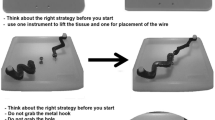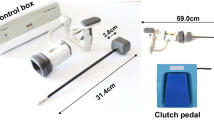Abstract
Background
In laparoscopic surgery, no external feedback on the magnitude of the force exerted is available. Hence, surgeons and residents tend to exert excessive force, which leads to tissue trauma. Ability of surgeons and residents to perceive their own force output without external feedback is a critical factor in laparoscopic force-skills training. Additionally, existing methods of laparoscopic training do not effectively train residents and novices on force-skills. Hence, there is growing need for the development of force-based training curriculum.
Objective
As a first step towards force-based laparoscopic skills training, this study analysed force perception difference between laparoscopic instrument and finger in contralateral bimanual passive probing task.
Methods
The study compared the isometric force matching performance of novices, residents and surgeons with finger and laparoscopic instrument. Contralateral force matching paradigm was employed to analyse the force perception capability in terms of relative (accuracy), and constant errors in force matching.
Results
Force perception of experts was found to be better than novices and residents. Interestingly, laparoscopic instrument was more accurate in discriminating the forces than finger. The dominant hand attempted to match the forces accurately, whereas non-dominant hand (NH) overestimated the forces. Further, the NH of experts was found to be most accurate. Furthermore, excessive forces were applied at lower force levels and at very high force levels.
Conclusions
Due to misperception of force, novices and residents applied excessive forces. However, experts had good control over force with both dominant and NHs. These findings suggest that force-based training curricula should not only have proprioception tasks, but should also include bimanual force-skills training exercises in order to improve force perception ability and hand skills of novices and residents. The results can be used as a performance metric in both box and virtual reality based force-skills training.











Similar content being viewed by others
References
Den Boer KT, Herder JL, Sjoerdsma W, Meijer DW, Gouma DJ, Stassen HG (1999) Sensitivity of laparoscopic dissectors: what can you feel? Surg Endosc 13:869–873
Perreault JO, Cao CGL (2006) Effects of vision and friction on haptic perception. Hum Factors 48:574–586
Picod G, Jambon AC, Vinatier D, Dubois P (2005) What can the operator actually feel when performing a laparoscopy? Surg Endosc 19:95–100
Joice P, Hanna GB, Cuschieri A (1998) Errors enacted during endoscopic surgery—a human reliability analysis. Appl Ergon 29:409–414
Tang B, Hanna GB, Cuschieri A (2005) Analysis of errors enacted by surgical trainees during skills training courses. Surgery 138:14–20
Way LW, Stewart L, Gantert W et al (2003) Causes and prevention of laparoscopic bile duct injuries—analysis of 252 cases from a human factors and cognitive psychology perspective. Ann Surg 237:460–469
Anup R, Balasubramanian KA (2000) Surgical stress and the gastrointestinal tract. J Surg Res 92:291–300
Marucci DD, Shakeshaft AJ, Cartmill JA et al (2000) Grasper trauma during laparoscopic cholecystectomy. Aust N Z J Surg 70:578–581
Reissman P, Tiong-Ann-Teoh Skinner K, Burns JW, Wexner SD (1996) Adhesion formation after laparoscopic anterior resection in a porcine model: a pilot study. Surg Laparosc Endosc Percutan Tech 6:136–139
Ottermo MV, Øvstedal M, Langø T, Stavdahl Ø, Yavuz Y, Johansen TA, Mårvik R (2006) The role of tactile feedback in laparoscopic surgery. Surg Laparosc Endosc Percutan Tech 16:390–400
Richards C, Rosen J, Hannaford B, Pellegrini C, Sinanan M (2000) Skills evaluation in minimally invasive surgery using force/torque signatures. Surg Endosc 14:791–798
Singapogu RB, Smith DE, Long LO, Burg TC, Pagano CC, Burg KJL (2012) Objective differentiation of force-based laparoscopic skills using a novel haptic simulator. J Surg Educ 69:766–773
Xin H, Zelek JS, B Carnahan H (2006) Laparoscopic surgery, perceptual limitations and force: a review. First Canadian Student Conference on Biomedical Computing; Kingston, Ontario, Canada
Gaar E (2004) Errors in laparoscopic surgery. J Surg Oncol 88:153–160
Singapogu R, DuBose S, Long L et al (2013) Salient haptic skills trainer: initial validation of a novel simulator for training force-based laparoscopic surgical skills. Surg Endosc 27:1653–1661
MacFarlane MP, Rosen J, Hannaford B, Pellegrini C, Sinanan MN (1999) Force-feedback grasper helps restore sense of touch in minimally invasive surgery. J Gastrointest Surg 3:278–285
Rosen J, Hannaford B, MacFarlane MP, Sinanan MN (1999) Force controlled and teleoperated endoscopic grasper for minimally invasive surgery: experimental performance evaluation. IEEE Trans Biomed Eng 46:1212–1221
Bholat S, Haluck RS, Murray WB, Gorman PJ, Krummel TM (1999) Tactile feedback is present during minimally invasive surgery. J Am Coll Surg 189:349–355
Xin H (2009) Perception of compliance in laparoscopic surgery. University of Waterloo, Ontario
Winters JM, Crago PE (2011) Biomechanics and neural control of posture and movement. Springer, London
Carson RG, Riek S, Shahbazpour N (2002) Central and peripheral mediation of human force sensation following eccentric or concentric contractions. J Physiol 539:913–925
Gandevia SC, McCloskey DI (1977) Changes in motor commands, as shown by changes in perceived heaviness, during partial curarization and peripheral anaesthesia in man. J Physiol 272:673–689
Gandevia SC, McCloskey DI (1977) Effects of related sensory inputs on motor performances in man studied through changes in perceived heaviness. J Physiol 272:653–672
Walsh LD, Taylor JL, Gandevia SC (2011) Overestimation of force during matching of externally generated forces. J Physiol 589:547–557
Jones LA (2003) Perceptual constancy and the perceived magnitude of muscle forces. Exp Brain Res 151:197–203
Jones LA (1989) Matching forces: constant errors and differential thresholds. Perception 18:681–687
Jones LA, Hunter IW (1983) Effect of fatigue on force sensation. Exp Neurol 81:640–650
Jones LA, Hunter IW (1982) Force sensation in isometric contractions: a relative force effect. Brain Res 244:186–189
Dobbelsteen JJ, Schooleman A, Dankelman J (2007) Friction dynamics of trocars. Surg Endosc 21:1338–1343
Dubois P, Thommen Q, Jambon AC (2002) In vivo measurement of surgical gestures. IEEE Trans Biomed Eng 49:49–54
Horeman T, Rodrigues SP, Jansen FW, Dankelman J, van den Dobbelsteen JJ (2012) Force parameters for skills assessment in laparoscopy. IEEE Trans Haptics 5:312–322
Horeman T, Rodrigues S, Jansen FW, Dankelman J, Dobbelsteen JJ (2010) Force measurement platform for training and assessment of laparoscopic skills. Surg Endosc 24:3102–3108
Park WH, Leonard C, Li S (2008) Finger force perception during ipsilateral and contralateral force matching tasks. Exp Brain Res 189:301–310
Shergill SS, Bays PM, Frith CD, Wolpert DM (2003) Two eyes for an eye: the neuroscience of force escalation. Science 301:187
Henningsen H, Ende-Henningsen B, Gordon A (1995) Asymmetric control of bilateral isometric finger forces. Exp Brain Res 105:304–311
Adamo D, Scotland S, Martin B (2012) Asymmetry in grasp force matching and sense of effort. Exp Brain Res 217:273–285
Elneel FHF, Carter F, Tang B, Cuschieri A (2008) Extent of innate dexterity and ambidexterity across handedness and gender: implications for training in laparoscopic surgery. Surg Endosc 22:31–37
Nieboer TE, Sari V, Kluivers KB, Weinans MJN, Vierhout ME, Stegeman DF (2012) A randomized trial of training the non-dominant upper extremity to enhance laparoscopic performance. Minim Invasive Ther Allied Technol 21:259–264
Suleman R, Yang T, Paige J, Chauvin S et al (2010) Hand-eye dominance and depth perception effects in performance on a basic laparoscopic skills set. J Soc Laparoendosc Surg Soc Laparoendosc Surg 14:35–40
Hanna GB, Drew T, Clinch P et al (1997) Psychomotor skills for endoscopic manipulations: differing abilities between right and left-handed individuals. Ann Surg 225:335–338
Grantcharov TP, Bardram L, Funch-Jensen P, Rosenberg J (2003) Impact of hand dominance, gender, and experience with computer games on performance in virtual reality laparoscopy. Surg Endosc Interv Tech 17:1082–1085
Powers TW, Bentrem DJ, Nagle AP, Toyama MT, Murphy SA, Murayama KM (2005) Hand dominance and performance in a laparoscopic skills curriculum. Surg Endosc Interv Tech 19:673–677
Tchantchaleishvili V, Myers PO (2010) Left-handedness—a handicap for training in surgery? J Surg Educ 67:233–236
Oms LM, Badia JM (2003) Laparoscopic cholecystectomy in situs inversus totalis: the importance of being left-handed. Surg Endosc Interv Tech 17:1859–1861
Makay O, Icoz G, Ersin S (2008) Surgeon’s view on the limitations of left-handedness during endoscopic surgery. J Laparoendosc Adv Surg Tech A 18:217–221
Oldfield RC (1971) The assessment and analysis of handedness: the Edinburgh inventory. Neuropsychologia 9:97–113
Haveran L, Novitsky Y, Czerniach D et al (2007) Optimizing laparoscopic task efficiency: the role of camera and monitor positions. Surg Endosc 21:980–984
Matern U, Faist M, Kehl K, Giebmeyer C, Buess G (2005) Monitor position in laparoscopic surgery. Surg Endosc Interv Tech 19:436–440
Rogers ML, Heath WB, Uy CC, Suresh S, Kaber DB (2012) Effect of visual displays and locations on laparoscopic surgical training task. Appl Ergon 43:762–767
Veelen MA, Jakimowicz JJ, Goossens RHM, Meijer DW, Bussmann JBJ (2002) Evaluation of the usability of two types of image display systems, during laparoscopy. Surg Endosc Interv Tech 16:674–678
Zhou M, Perreault J, Schwaitzberg S, Cao C (2008) Effects of experience on force perception threshold in minimally invasive surgery. Surg Endosc 22(2):510–515
Chase C, Seidler R (2008) Degree of handedness affects intermanual transfer of skill learning. Exp Brain Res 190:317–328
Acknowledgments
The authors thank all the surgical residents and expert surgeons of surgical gastroenterology department, Rajiv Gandhi Government General Hospital, Chennai, India, who willingly participated in the experiments. The authors acknowledge the support of Dr. Sandeep in coordinating with the subjects for the experiments. The authors also extend thanks to the editor(s) and anonymous reviewers for their insightful comments towards improving the quality of the manuscript.
Disclosures
M.S.Raghu Prasad, M.Manivanan and S.M Chandramohan have no conflicts of interest or financial ties to disclose.
Author information
Authors and Affiliations
Corresponding author
Rights and permissions
About this article
Cite this article
Raghu Prasad, M.S., Manivannan, M. & Chandramohan, S.M. Effects of laparoscopic instrument and finger on force perception: a first step towards laparoscopic force-skills training. Surg Endosc 29, 1927–1943 (2015). https://doi.org/10.1007/s00464-014-3887-x
Received:
Accepted:
Published:
Issue Date:
DOI: https://doi.org/10.1007/s00464-014-3887-x




